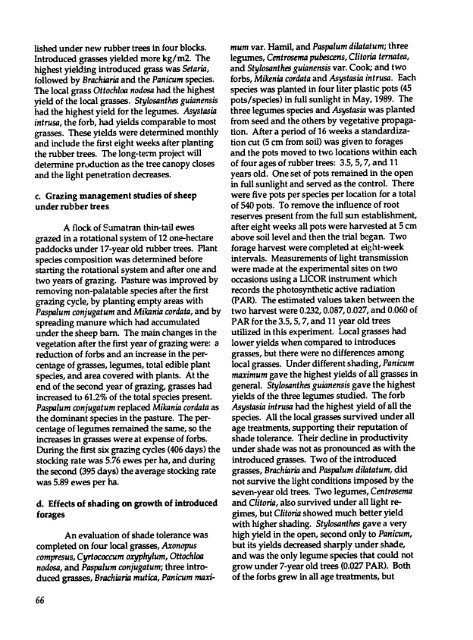Research Results - (PDF, 101 mb) - USAID
Research Results - (PDF, 101 mb) - USAID
Research Results - (PDF, 101 mb) - USAID
Create successful ePaper yourself
Turn your PDF publications into a flip-book with our unique Google optimized e-Paper software.
lished under new rubber trees in four blocks,<br />
Introduced grasses yielded more kg/m2. The<br />
highest yielding introduced grass was Setaria,<br />
followed by Brachiariaand the Panicumspecies.<br />
The local grass Ottochloanodosa had the highest<br />
yield of the local grasses. Stylosanthesguianensis<br />
had the highest yield for the legumes. Asystasia<br />
intrusa,the forb, had yields comparable to most<br />
grasses. These yields were determined monthly<br />
and include the first eight weeks after planting<br />
the rubber trees. The long-term project will<br />
determine pruduction as the tree canopy closes<br />
and the light penetration decreases.<br />
c. Grazing management studies of sheep<br />
under rubber trees<br />
A flock of Sunatran thin-tail ewes<br />
grazed in a rotational system of 12 one-hectare<br />
paddocks under 17-year old rubber trees. Plant<br />
species composition was determined before<br />
starting the rotational system and after one and<br />
two years of grazing. Pasture was improved by<br />
removing non-palatable species after the first<br />
grazing cycle, by planting empty areas with<br />
Paspalumconjugatumand Mikania cordata,and by<br />
spreading manure which had accumulated<br />
under the sheep barn. The main changes in the<br />
vegetation after the first year of grazing were: a<br />
reduction of forbs and an increase in the percentage<br />
of grasses, legumes, total edible plant<br />
species, and area covered with plants. At the<br />
end of the second year of grazing, grasses had<br />
increased to 61.2% of the total species present.<br />
Paspalumconjugatum replaced Mikania cordataas<br />
the dominant species in the pasture. The percentage<br />
of legumes remained the same, so the<br />
increases in grasses were at expense of forbs.<br />
During the first six grazing cycles (406 days) the<br />
stocking rate was 5.76 ewes per ha, and during<br />
the second (395 days) the average stocking rate<br />
was 5.89 ewes per ha.<br />
d. Effects of shading on growth of introduced<br />
forages<br />
An evaluation of shade tolerance was<br />
completed on four local grasses, Axonopus<br />
compresus, Cyrtococcum oxyphylum, Ottochloa<br />
nodosa, andPaspalumconjugatum;three introduced<br />
grasses, Brachiariamutica, Panicummaxi-<br />
66<br />
mum var. Hamil, and Paspalumdilatatum;three<br />
legumes, Centrosemapubescens, Clitoriaternatea,<br />
and Stylosanthes guianensisvar. Cook; and two<br />
forbs, Mikenia cordataand Asystasia intrusa. Each<br />
species was planted in four liter plastic pots (45<br />
pots/species) in full sunlight in May, 1989. The<br />
three legumes species and Asystasia was planted<br />
from seed and the others by vegetative propagation.<br />
After a period of 16 weeks a standardization<br />
cut (5 cm from soil) was given to forages<br />
and the pots moved to two locations within each<br />
of four ages of rubber trees: 3.5, 5, 7, and 11<br />
years old. One set of pots remained in the open<br />
in full sunlight and served as the control. There<br />
were five pots per species per location for a total<br />
of 540 pots. To remove the influence of root<br />
reserves present from the full sun establishment,<br />
after eight weeks all pots were harvested at 5cm<br />
above soil level and then the trial began. Two<br />
forage harvest were completed at eight-week<br />
intervals. Measurements of light transmission<br />
were made at the experimental sites on two<br />
occasions using a LICOR instrument which<br />
records the photosynthetic active radiation<br />
(PAR). The estimated values taken between the<br />
two harvest were 0.232,0.087,0.027, and 0.060 of<br />
PAR for the 3.5, 5, 7, and 11 year old trees<br />
utilized in this experiment. Local grasses had<br />
lower yields when compared to introduces<br />
grasses, but there were no differences among<br />
local grasses. Under different shading, Panicum<br />
maximum gave the highest yields of all grasses in<br />
general. Stylosanthes guianensisgave the highest<br />
yields of the three legumes studied. The forb<br />
Asystasia intrusahad the highest yield of all the<br />
species. All the local grasses survived under all<br />
age treatments, supporting their reputation of<br />
shade tolerance. Their decline in productivity<br />
under shade was not as pronounced as with the<br />
introduced grasses. Two of the introduced<br />
grasses, Brachiariaand Paspalumdilatatum,did<br />
not survive the light conditions imposed by the<br />
seven-year old trees. Two legumes, Centrosema<br />
and Clitoria,also survived under all light regimes,<br />
but Clitoriashowed much better yield<br />
with higher shading. Stylosanthes gave a very<br />
high yield in the open, second only to Panicum,<br />
but its yields decreased sharply under shade,<br />
and was the only legume species that could not<br />
grow under 7-year old trees (0.027 PAR). Both<br />
of the forbs grew in all age treatments, but

















